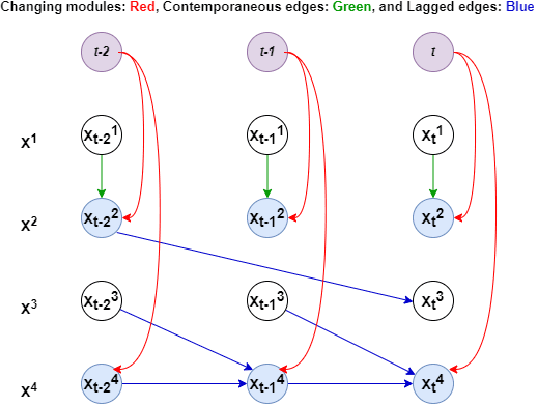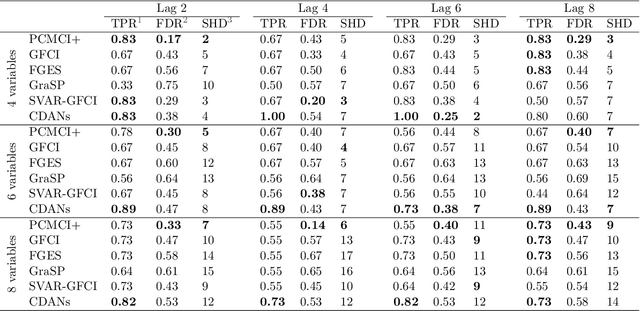Uzma Hasan
Causality for Earth Science -- A Review on Time-series and Spatiotemporal Causality Methods
Apr 03, 2024Abstract:This survey paper covers the breadth and depth of time-series and spatiotemporal causality methods, and their applications in Earth Science. More specifically, the paper presents an overview of causal discovery and causal inference, explains the underlying causal assumptions, and enlists evaluation techniques and key terminologies of the domain area. The paper elicits the various state-of-the-art methods introduced for time-series and spatiotemporal causal analysis along with their strengths and limitations. The paper further describes the existing applications of several methods for answering specific Earth Science questions such as extreme weather events, sea level rise, teleconnections etc. This survey paper can serve as a primer for Data Science researchers interested in data-driven causal study as we share a list of resources, such as Earth Science datasets (synthetic, simulated and observational data) and open source tools for causal analysis. It will equally benefit the Earth Science community interested in taking an AI-driven approach to study the causality of different dynamic and thermodynamic processes as we present the open challenges and opportunities in performing causality-based Earth Science study.
KGS: Causal Discovery Using Knowledge-guided Greedy Equivalence Search
Apr 11, 2023



Abstract:Learning causal relationships solely from observational data provides insufficient information about the underlying causal mechanism and the search space of possible causal graphs. As a result, often the search space can grow exponentially for approaches such as Greedy Equivalence Search (GES) that uses a score-based approach to search the space of equivalence classes of graphs. Prior causal information such as the presence or absence of a causal edge can be leveraged to guide the discovery process towards a more restricted and accurate search space. In this study, we present KGS, a knowledge-guided greedy score-based causal discovery approach that uses observational data and structural priors (causal edges) as constraints to learn the causal graph. KGS is a novel application of knowledge constraints that can leverage any of the following prior edge information between any two variables: the presence of a directed edge, the absence of an edge, and the presence of an undirected edge. We extensively evaluate KGS across multiple settings in both synthetic and benchmark real-world datasets. Our experimental results demonstrate that structural priors of any type and amount are helpful and guide the search process towards an improved performance and early convergence.
A Survey on Causal Discovery Methods for Temporal and Non-Temporal Data
Apr 05, 2023Abstract:Causal Discovery (CD) is the process of identifying the cause-effect relationships among the variables of a system from data. Over the years, several methods have been developed primarily based on the statistical properties of data to uncover the underlying causal mechanism. In this study, we present an extensive discussion on the methods designed to perform causal discovery from both independent and identically distributed (i.i.d.) data and time series data. For this purpose, we first introduce the common terminologies in causal discovery, and then provide a comprehensive discussion of the algorithms designed to identify the causal edges in different settings. We further discuss some of the benchmark datasets available for evaluating the performance of the causal discovery methods, available tools or software packages to perform causal discovery readily, and the common metrics used to evaluate these methods. We also test some common causal discovery algorithms on different benchmark datasets, and compare their performances. Finally, we conclude by presenting the common challenges involved in causal discovery, and also, discuss the applications of causal discovery in multiple areas of interest.
eCDANs: Efficient Temporal Causal Discovery from Autocorrelated and Non-stationary Data (Student Abstract)
Mar 06, 2023
Abstract:Conventional temporal causal discovery (CD) methods suffer from high dimensionality, fail to identify lagged causal relationships, and often ignore dynamics in relations. In this study, we present a novel constraint-based CD approach for autocorrelated and non-stationary time series data (eCDANs) capable of detecting lagged and contemporaneous causal relationships along with temporal changes. eCDANs addresses high dimensionality by optimizing the conditioning sets while conducting conditional independence (CI) tests and identifies the changes in causal relations by introducing a surrogate variable to represent time dependency. Experiments on synthetic and real-world data show that eCDANs can identify time influence and outperform the baselines.
CDANs: Temporal Causal Discovery from Autocorrelated and Non-Stationary Time Series Data
Feb 07, 2023



Abstract:This study presents a novel constraint-based causal discovery approach for autocorrelated and non-stationary time series data (CDANs). Our proposed method addresses several limitations of existing causal discovery methods for autocorrelated and non-stationary time series data, such as high dimensionality, the inability to identify lagged causal relationships, and the overlook of changing modules. Our approach identifies both lagged and instantaneous/contemporaneous causal relationships along with changing modules that vary over time. The method optimizes the conditioning sets in a constraint-based search by considering lagged parents instead of conditioning on the entire past that addresses high dimensionality. The changing modules are detected by considering both contemporaneous and lagged parents. The approach first detects the lagged adjacencies, then identifies the changing modules and contemporaneous adjacencies, and finally determines the causal direction. We extensively evaluated the proposed method using synthetic datasets and a real-world clinical dataset and compared its performance with several baseline approaches. The results demonstrate the effectiveness of the proposed method in detecting causal relationships and changing modules in autocorrelated and non-stationary time series data.
 Add to Chrome
Add to Chrome Add to Firefox
Add to Firefox Add to Edge
Add to Edge